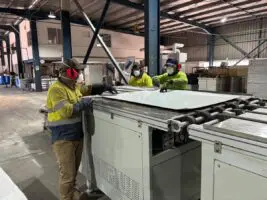The price is right: Does affordable solar change everything? That was the provocative title to a session at the excellent 2nd Summer Study on Energy Efficiency and Decentralised Energy in Sydney last week, and provided some fascinating insights into just how close we are to a solar revolution in this country. Indeed, we may already be at the start of it.
According to the Australian PV Association, rooftop solar PV made up around 80 per cent of all Australian electricity installations in 2012. While developers of large-scale wind and solar farms struggled to attract the interest of the big utilities, who were reluctant to commit amid the ongoing policy uncertainty, Australian households invested nearly $3 billion of their own money to generate some of their own power from their own rooftops.
Some of this investment was motivated by the energy “profits” that could be generated from lingering feed-in tariffs, and the rush to cash in Queensland, but new data from Sunwiz Consulting suggests most installations are now from people looking to make energy savings.
Here’s why – and a graph is always best to illustrate the point. It comes from APVA chairwoman Muriel Watt, who used it at the summer study to explain why solar PV is now hitting the right price point in Australia.
The blue line below is the “base-case” scenario (from 2011), about the cost of rooftop solar PV. The blue star indicates where prices are now.
Compare this with the dotted red and black lines, which indicates the high and low scenarios for retail electricity prices. The top two lines – in yellow and red – indicate the net present value of grid electricity over the next 10 years, which is probably the best comparison to make when considering investments.
“Solar PV is at the stage where the question is ‘why wouldn’t you do it’,” Watt told the seminar. “There is no noise, no moving parts, little visual impact.”
Watt says the fall in the price of solar modules, from $12/watt to $2/watt over the past four years, and rising grid prices, means “socket” parity has been reached for households, and many businesses, and solar PV is cost effective in most places in Australia.
The problem, Watt notes, is that affordable solar is such a disruptive technology because it changes the way we need to think about energy – how we use it, how we generate it, and how we build it. As RenewEconomy – and major investment banks such as UBS, Macquarie Group and Deutsche Bank – have noted, that is causing headaches for utilities now, and Watt says the same applies to energy ministers who, in Australia, are the owners of such assets.
The biggest fear is some sort of regulatory backlash from utilities and network operators fearful of declining revenues. In Queensland, the first signs of that have emerged. Watt also cites the case of commercial solar – where little has been installed in Australian because of huge connection fees, or moves by network operators to move to flat tariffs.
“The commercial sector have an added incentive because solar matches their load (demand). But there is a big push-back by utilities, having been complacent with what would happen with residential PV, they see massive reductions in energy use from the commercial sector.”
Here’s another graph, using similar metrics for the commercial sector, which does care deeply about NPV when considering investments.
Watt says market access will become a significant issue, and the challenge for network operators was to rethink how grid is operated and how the network is planned. “For the first time, customers have options, and this is the game changer.”
Hence the uncertainty in solar PV forecasts for Australia. A lot depends on how the network operators and the regulators respond.
In Australia, the APVA predicts that the solar PV market could fall from around 1,000MW in 2012 to 800MW in 2013 and to close to 500MW in 2014, before regaining its current level of 1,000MW by the end of the decade. This is without a carbon price, although the final number is more likely to depend more on the fate of the renewable energy target, particularly for large-scale solar PV.
Watt expects around 8,000MW (8GW) in Australia by 2020, while other forecasts range between 4GW (there is already nearly 2.5GW) and 11GW. The Australian Energy Market Operator last year suggested 12-18GW from residential rooftops by 2031, while 15 per cent compound growth would deliver 34GW by that time.
Nick Lake – the local boss of Sungevity, the US firm about to launch its solar leasing model in Australia later this month – says that affordable solar will transform the Australian energy economy.
“It is happening now,” Lake said. “The adaptation of solar in a high-tech trajectory, just like mobile phones. Get ready for a ride, because mobile phones are pretty much zero-cost in your phone plan, and solar will be offering something similar to your energy plan.”
Still, noone is too sure how the “democratisation of energy” – the ability for households to generate power on their rooftops – will play out. “It’s a recent phenomenon,” Lake said. “I don’t think anyone has a clear picture of what that is going to mean. The utilities are struggling to catch up and understand how it will affect them.”







